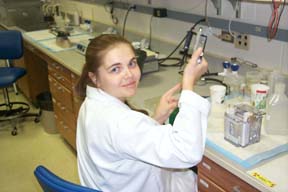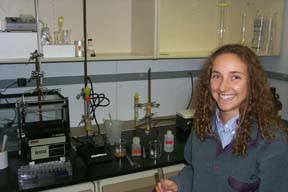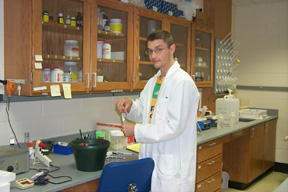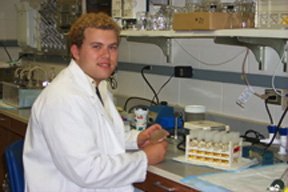Home |
Regina Stevens-Truss, Ph.D.
Research Students
Current / Former
Ms. Irena Gribovskaja

a Kalamazoo College Health Sciences major (class of 2003) is currently attending the University of Wisconsin Medical School. She conducted her Senior Individualized Project (SIP) entitled "Effects of calmodulin's calcium binding sites II and IV on the activity of inducible nitric oxide synthase" in the lab (summer 2002) as a Howard Hughes Medical Institute Student Research Fellow (Kalamazoo College). Her research was done in an effort to complete phase 1 of the main project that has been ongoing in my lab for two years. The completion of phase 1 (understanding how calcium's interaction with calmodulin affects calmodulin's ability to activate NOS) has launched us into phase 2 (determination of the amino acid residues that are involved in the interactions between CaM and NOS) of this project. Her results in combination with previous data from this lab are being submitted to Biochemistry (Sept. 2004).
Ms. Whitney Goode

a Kalamazoo College Chemistry major (class of 2003) is
attending Tufts University
Dental School. Her SIP project entitled "Spectral analysis of the
effects that solvent composition has on the heme Soret of nitric oxide
synthase" was conducted as preliminary studies for phase 2 of the
lab's research plans (summer 2002). Her research yielded information
about the amino acid composition of the active sites of the neuronal and
inducible NOSs that will be useful in the design of active site inhibitor
molecules. Based on the crystal structures of the heme domain of
the NOSs it has been speculated that the active site pockets decrease
in the order neuronal > inducible > endothelial (Gerber, N. C.,
et al., 1997, JBC, 272:6285). Whitney's research supports this
previous observation, and is the first time that solvent effects on the
active site of NOS has been investigated.
Summer of 2001:
Mr. Sam Dennis

a Kalamazoo College Health Sciences major (class of 2002) conducted his SIP in the lab (done summer 2001). His thesis entitled "The effects that mutating calcium binding site III of calmodulin has on the activity of inducible nitric oxide synthase" was a continuation of work started in the lab during the summer of 2000. Our previous work (Stevens-Truss, R., et al., 1997, Biochem., 36:12337) had demonstrated that this mutation had little effect on the neuronal NOS. This research was important to our quest at understanding the differences in calmodulin's activation of NOSs (Manuscript submitted to Biochemistry, Sept. 2004).
Ms. Patrice Fields

a Kalamazoo College Chemistry major (class of 2004) is attending
The University of Cincinnati majoring
in Chemistry. Patrice worked in the lab during the summer of her
first year at Kalamazoo College (summer 2001). She was one of 7
students awarded a Research Fellowship through Kalamazoo College's Howard
Hughes Medical Institute student researcher program during the summer
of 2001. Her worked has significance in our understanding of nitric
oxide synthase and its inhibition by the P450 inhibitor Oltipraz, and
a manuscript resulted from her work (Furge, L. L., et al, 2004,
ABB, 424:163). Patrice was
also instrumental in helping to develop a new line of investigations currently
being conducted in the lab (in collaboration with Dr. D. Blaine Moore,
Kalamazoo College) whereby we are studying the molecular mechanisms of
microglial cell activation.
Summer of
2000/2001:
Mr. Kaleb Brownlow

a Kalamazoo College Biology major (class of 2001), is attending
The Jackson School of International
Studies, MAIS Program in Seattle, WA. His SIP project (done summer
2000) entitled "Activity of Inducible Nitric Oxide Synthase Requires
Bound Calcium at Either Site I or Site III of Calmodulin" was
the first set of experiments done that compared the Ca2+-binding sites
of CaM with respect to activation of iNOS (Manuscript submitted to Biochemistry,
Sept. 2004). Kaleb continued to work in
the lab during the summer of 2001 following graduation on a pilot project
in collaboration with Dr. Hank Mossberg
(The University of Michigan) and Dr.
Vivien Pybus (Kalamazoo College),
screening peptides as potential anti-microbial agents.